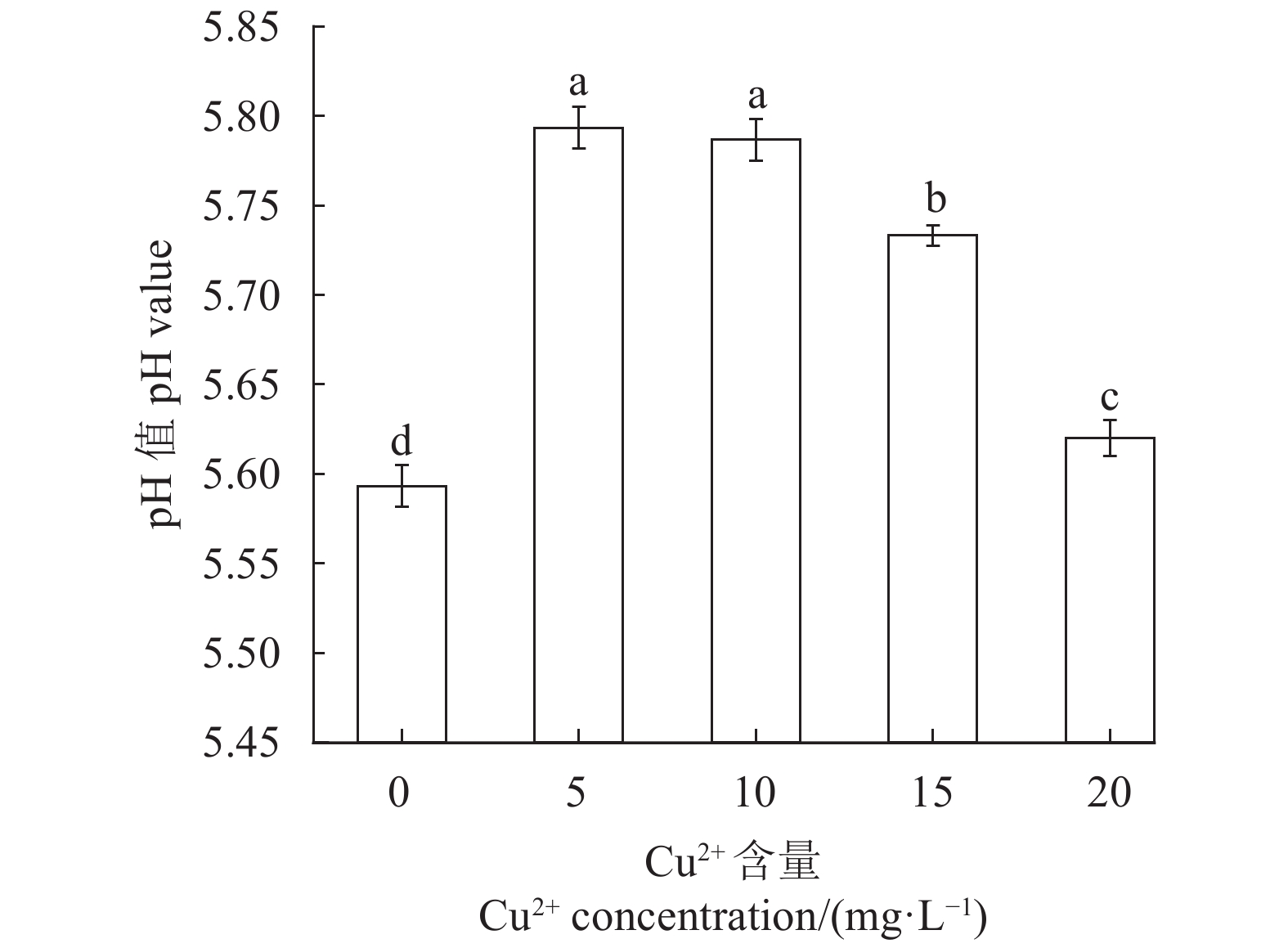Physiological and Biochemical Correlations between Color of Impatiens uliginosa Flower and Nutrient Supply on Copper
-
摘要:
目的 探讨滇水金凤花色对重金属铜离子的响应。 方法 以滇水金凤为试验材料,研究其在不同含量Cu2+(0、5、10、15、20 mg·L−1)处理下盛花期花瓣的色度值、细胞液pH值、色素和基础代谢物含量的变化,并分析Cu2+、各生理生化指标与花色之间的关系。 结果 (1)花色苷、总黄酮和可溶性糖含量随Cu2+含量增加而下降,与对照比均达显著差异性(P<0.05);(2)随Cu2+含量增加,可溶性蛋白含量不断增加,与对照比均达显著差异性(P<0.05);(3)Cu2+含量在0~15 mg·L−1时,类胡萝卜素和脯氨酸含量无明显变化;(4)相关性分析表明,不同含量Cu2+处理下花瓣色度值、花色苷、总黄酮、可溶性糖、脯氨酸、可溶性蛋白等几个指标间均存在极显著相关性;(5)运用逐步回归分析发现,色相a*值、b*值主要受花色苷、可溶性糖和脯氨酸等因子影响。 结论 花色苷含量是影响滇水金凤花色变化的直接因素;而Cu2+是通过调控滇水金凤花色苷的生物合成来影响花瓣呈色。 Abstract:Objective Response of Impatiens uliginosa to copper ions on the floral color with respect of the physiological and biochemical properties of the petals was investigated. Method Under treatments of varied Cu2+ concentrations (i.e., 0, 5, 10, 15, and 20 mg·L−1) in culture medium, the chromaticity, pH of cell fluid, pigments, and basal metabolites of flower petals of the I. uliginosa at full blooming stage were determined. The correlations among Cu2+, physiological and biochemical indices, and flower color were analyzed. Result (1) The contents of anthocyanins, flavonoids, and soluble sugars in petals decreased significantly in comparison to control as the Cu2+ concentration increased (P<0.05). (2) Soluble protein increased significantly over control with increasing Cu2+ at P<0.05. (3) In the range of 0-15 mg·L−1, Cu2+ exerted no significant effect in the contents of carotenoids and proline. (4) There were extremely significant correlations among the color values, anthocyanins, flavonoids, soluble sugar, proline, and soluble protein of petals on the plants treated by Cu2+ at different concentrations. (5) The stepwise regression analysis showed that the flower chromaticity a* and b* were mainly affected by anthocyanins, soluble sugar and proline. Conclusion Anthocyanin appeared to directly govern the color of I. uliginosa flowers. Cu2+ seemed to affect the petal color through regulating anthocyanin biosynthesis inI. uliginosa. -
Key words:
- Impatiens uliginosa /
- Cu2+ /
- flower color /
- pigments /
- basal metabolite
-
表 1 不同含量Cu2+处理下滇水金凤花瓣色度值变化
Table 1. Flower petal chromaticity of I. uliginosa treated with different concentration of Cu2+
Cu2+含量
Cu2+ concentration/(mg·L−1)L* a* b* C* h(°) 0(CK) 56.61±0.94 a 29.27±1.25 a −13.75±1.08 c 32.34±1.55 a −25.16±1.02 a 5 56.86±1.28 a 24.26±0.15 c −11.66±0.65 b 26.93±0.26 c −25.68±1.30 a 10 55.20±1.12 a 25.76±0.70 b −14.73±1.68 c 29.69±1.42 b −29.70±2.23 b 15 56.63±2.04 a 22.46±0.25 d −11.03±0.77 b 25.03±0.12 d −26.16±1.84 a 20 51.60±0.26 b 17.60±0.43 e −8.06±0.15 a 19.36±0.45 e −24.63±0.24 a 注:同列数据后不同小写字母表示差异显著(P<0.05)。
Note: Data with different lowercase letters on same column indicate significant difference at P<0.05.表 2 Cu2+、各生理生化指标与花色之间的相关关系
Table 2. Correlation between Cu2+, physiological and biochemical indices, and flower color
指标
IndexCu2+ L* a* b* pH AC CC FC SS SP Pro Cu2+ 1 L* −0.535* 1 a* −0.884** 0.364 1 b* 0.709** −0.475 −0.886** 1 pH 0.033 0.124 −0.09 −0.065 1 AC −0.927** 0.479 0.939** −0.821** −0.099 1 CC 0.196 −0.439 −0.243 0.475 −0.353 −0.296 1 FC −0.775** 0.514* 0.646** −0.418 −0.243 0.679** −0.264 1 SS −0.971** 0.625* 0.854** −0.725** −0.022 0.921** −0.211 0.732** 1 SP 0.884** −0.632* −0.675** 0.589* −0.301 −0.779** 0.246 −0.604* −0.918** 1 Pro −0.499 0.336 0.729** −0.715** 0.004 0.567* −0.366 0.46 0.449 −0.248 1 注:*和**分别表示在0.05和0.01水平上相关性显著。
Note:* and ** indicate significant correlations at P<0.05 and P<0.01, respectively.表 3 Cu2+、各生理生化指标与花色之间的逐步回归分析
Table 3. Stepwise regression on Cu2+, physiological and biochemical indices, and flower color
指标
Index逐步回归方程
Stepwise regression equationF值
F value复相关系数
Multiple correlation coefficientCu2+ Cu2+=23.313-0.997a*+2.007A 188.228 0.969 a* a*=2.807+10.054B+0.086C 89.103 0.937 b* b*=3.071-0.856a*+0.476D 33.387 0.848 注:A为可溶性蛋白含量;B为花色苷含量;C为脯氨酸含量;D为可溶性糖含量。
Note: A: soluble protein content; B: anthocyanin content; C: proline content; D: soluble sugar content. -
[1] SONG Y, YUAN Y M, KÜPFER P. Chromosomal evolution in Balsaminaceae, with cytological observations on 45 species from Southeast Asia [J]. Caryologia, 2003, 56(4): 463−481. doi: 10.1080/00087114.2003.10589359 [2] 于胜祥. 中国凤仙花 [M]. 北京: 北京大学出版社, 2012. [3] 李洋, 黄武略, 林福永, 等. 滇水金凤CHI基因的克隆及表达分析 [J]. 江西农业大学学报, 2020, 42(3):468−474.LI Y, HUANG W L, LIN F Y, et al. Cloning and expression analysis of CHI genes in Impatiens uliginosa [J]. Acta Agriculturae Universitatis Jiangxiensis, 2020, 42(3): 468−474.(in Chinese) [4] 刘应丽, 冯志熙, 朱佳鹏, 等. 滇水金凤花发育AP3/DEF同源基因的克隆及表达分析 [J]. 分子植物育种, 2020, 18(20):6626−6632.LIU Y L, FENG Z X, ZHU J P, et al. Cloning and expression analysis of AP3/DEF homologous genes associated with floral development in Impatiens uliginosa [J]. Molecular Plant Breeding, 2020, 18(20): 6626−6632.(in Chinese) [5] LUO C, HUANG W, ZHU J P, et al. The complete chloroplast genome of Impatiens uliginosa Franch., an endemic species in Southwest China [J]. Mitochondrial DNA Part B, Resources, 2019, 4(2): 3846−3847. doi: 10.1080/23802359.2019.1687024 [6] 郭佳炜, 黄奇, 马明兰, 等. 不同花色云南野生凤仙花花瓣中金属元素测定 [J]. 安徽农业科学, 2019, 47(2):179−181. doi: 10.3969/j.issn.0517-6611.2019.02.055GUO J W, HUANG Q, MA M L, et al. Determination of metal elements in the petals of Yunnan wild Impatiens in different colors [J]. Journal of Anhui Agricultural Sciences, 2019, 47(2): 179−181.(in Chinese) doi: 10.3969/j.issn.0517-6611.2019.02.055 [7] KIANI M, MOHAMMADI S, BABAEI A, et al. Iran supports a great share of biodiversity and floristic endemism for Fritillaria spp. (Liliaceae): A review [J]. Plant Diversity, 2017, 39(5): 245−262. doi: 10.1016/j.pld.2017.09.002 [8] DEGUCHI A, OHNO S, HOSOKAWA M, et al. Endogenous post-transcriptional gene silencing of flavone synthase resulting in high accumulation of anthocyanins in black Dahlia cultivars [J]. Planta, 2013, 237(5): 1325−1335. doi: 10.1007/s00425-013-1848-6 [9] MORITA Y, HOSHINO A. Recent advances in flower color variation and patterning of Japanese morning glory and Petunia [J]. Breeding Science, 2018, 68(1): 128−138. doi: 10.1270/jsbbs.17107 [10] OHMIYA A. Molecular mechanisms underlying the diverse array of petal colors in Chrysanthemum flowers [J]. Breeding Science, 2018, 68(1): 119−127. doi: 10.1270/jsbbs.17075 [11] NODA N. Recent advances in the research and development of blue flowers [J]. Breeding Science, 2018, 68(1): 79−87. doi: 10.1270/jsbbs.17132 [12] 吴艳梅, 吴艺萍, 金雪花, 等. 丽格海棠花青素苷成分及分布对花色的影响 [J]. 西北植物学报, 2020, 40(1):58−68.WU Y M, WU Y P, JIN X H, et al. Effects of anthocyanin composition and distribution on flower color of rieger Begonia [J]. Acta Botanica Boreali-Occidentalia Sinica, 2020, 40(1): 58−68.(in Chinese) [13] 江洁蓓, 梁玲, 张腾驹, 等. 粉红珙桐叶片呈色相关生理特性的季节变化 [J]. 西北植物学报, 2019, 39(11):2019−2027.JIANG J B, LIANG L, ZHANG T J, et al. Seasonal dynamic of physiological characteristics of pink Davidia involucrata [J]. Acta Botanica Boreali-Occidentalia Sinica, 2019, 39(11): 2019−2027.(in Chinese) [14] ITO T, OYAMA K I, YOSHIDA K. Direct observation of Hydrangea blue-complex composed of 3-O-glucosyldelphinidin, Al3+ and 5-O-acylquinic acid by ESI-mass spectrometry [J]. Molecules, 2018, 23(6): 1424. doi: 10.3390/molecules23061424 [15] ITO T, AOKI D, FUKUSHIMA K, et al. Direct mapping of Hydrangea blue-complex in sepal tissues of Hydrangea macrophylla [J]. Scientific Reports, 2019, 9(1): 1−9. [16] TAKEDA K, TOMINAGA S. The anthocyanin in blue flowers of Centaurea cyanus [J]. The Botanical Magazine = Shokubutsu-Gaku-Zasshi, 1983, 96(4): 359−363. [17] YOSHIDA K, KITAHARA S, ITO D, et al. Ferric ions involved in the flower color development of the Himalayan blue poppy, Meconopsis grandis [J]. Phytochemistry, 2006, 67(10): 992−998. doi: 10.1016/j.phytochem.2006.03.013 [18] 李荣华. 铜和铝对新几内亚凤仙生长发育及花色的影响[D]. 保定: 河北农业大学, 2005.LI R H. Effects of copper and aluminium on growth and flower color of Impatiens hawkeri[D]. Baoding: Hebei Agricultural University, 2005. (in Chinese) [19] 王小菁, 孟祥春, 彭建宗. 花色形成与花生长的调控 [J]. 西北植物学报, 2003, 23(7):49−54.WANG X J, MENG X C, PENG J Z. Regulation of flower growth and pigmentation [J]. Acta Botanica Boreali-Occidentalia Sinica, 2003, 23(7): 49−54.(in Chinese) [20] 陈小红, 韦莉, 黄玉琼, 等. 鸳鸯茉莉花色变化过程中的生理生化特性研究 [J]. 植物科学学报, 2018, 36(4):595−602.CHEN X H, WEI L, HUANG Y Q, et al. Study on the physiological and biochemical characteristics of Brunfelsia acuminata petals during flowering [J]. Plant Science Journal, 2018, 36(4): 595−602.(in Chinese) [21] GRLESBACH R J. The inheritance of flower color in Petunia hybrida vilm [J]. Journal of Heredity, 1996, 87(3): 241−245. doi: 10.1093/oxfordjournals.jhered.a022993 [22] 李合生. 植物生理生化试验原理和技术[M]. 北京: 高等教育出版社, 2000: 134-263. [23] 李力, 张盛楠, 刘亚敏, 等. 基于Lab模型的北美红枫呈色生理因素探究 [J]. 西北农林科技大学学报(自然科学版), 2017, 45(9):87−94.LI L, ZHANG S N, LIU Y M, et al. Lab model based analysis on physiological factors affecting color of Acer rubrum L [J]. Journal of Northwest A & F University (Natural Science Edition), 2017, 45(9): 87−94.(in Chinese) [24] YOSHIDA K, KAWACHI M, MORI M, et al. The involvement of tonoplast proton pumps and na+(K+)/H+ exchangers in the change of petal color during flower opening of morning glory, Ipomoea tricolor cv. heavenly blue [J]. Plant and Cell Physiology, 2005, 46(3): 407−415. doi: 10.1093/pcp/pci057 [25] 付林江, 李厚华, 李玲, 等. 金银花花色变化原因分析 [J]. 林业科学, 2013, 49(10):155−161.FU L J, LI H H, LI L, et al. Reason of flower color change in Lonicera japonica [J]. Scientia Silvae Sinicae, 2013, 49(10): 155−161.(in Chinese) [26] PRIMKA E J, SMITH W K. Synchrony in fall leaf drop: Chlorophyll degradation, color change, and abscission layer formation in three temperate deciduous tree species [J]. American Journal of Botany, 2019, 106(3): 377−388. doi: 10.1002/ajb2.1247 [27] KARANJALKER G R, RAVISHANKAR K V, SHIVASHANKARA K S, et al. A study on the expression of genes involved in carotenoids and anthocyanins during ripening in fruit peel of green, yellow, and red colored mango cultivars [J]. Applied Biochemistry and Biotechnology, 2018, 184(1): 140−154. doi: 10.1007/s12010-017-2529-x [28] 葛雨萱, 王亮生, 徐彦军, 等. 蜡梅的花色和花色素组成及其在开花过程中的变化 [J]. 园艺学报, 2008, 35(9):1331−1338. doi: 10.3321/j.issn:0513-353X.2008.09.013GE Y X, WANG L S, XU Y J, et al. Flower color, pigment composition and their changes during flowering in Chimonanthus praecox link [J]. Acta Horticulturae Sinica, 2008, 35(9): 1331−1338.(in Chinese) doi: 10.3321/j.issn:0513-353X.2008.09.013 [29] 张超, 高金锋, 李彦慧, 等. 低温对2种玉兰花色及相关酶活性的影响 [J]. 林业科学, 2012, 48(7):56−60. doi: 10.11707/j.1001-7488.20120709ZHANG C, GAO J F, LI Y H, et al. Effect of low temperature on flower color and relevant enzymes activity of two Magnolia species [J]. Scientia Silvae Sinicae, 2012, 48(7): 56−60.(in Chinese) doi: 10.11707/j.1001-7488.20120709 [30] 陈华, 陈永快, 王涛, 等. 水杨酸对镉胁迫下不结球白菜幼苗生长及生理的响应 [J]. 福建农业学报, 2020, 35(12):1321−1329.CHEN H, CHEN Y K, WANG T, et al. Effects of salicylic acid on growth and physiology of non-heading Chinese cabbage seedlings under cadmium stress [J]. Fujian Journal of Agricultural Sciences, 2020, 35(12): 1321−1329.(in Chinese) [31] 梁玲, 江洁蓓, 张腾驹, 等. 不同色彩珙桐苞片与叶片的生理特性研究 [J]. 植物研究, 2020, 40(4):505−513. doi: 10.7525/j.issn.1673-5102.2020.04.004LIANG L, JIANG J B, ZHANG T J, et al. Physiological characteristics of Davidia involucrata bracts and leaves with different colors [J]. Bulletin of Botanical Research, 2020, 40(4): 505−513.(in Chinese) doi: 10.7525/j.issn.1673-5102.2020.04.004 [32] 聂庆娟, 史宝胜, 孟朝, 等. 不同叶色红栌叶片中色素含量、酶活性及内含物差异的研究 [J]. 植物研究, 2008, 28(5):599−602. doi: 10.7525/j.issn.1673-5102.2008.05.020NIE Q J, SHI B S, MENG Z, et al. The enzyme activities, pigment and inclusion contents in different leaves color of Cotinus coggygria ‘royal purple' in autumn [J]. Bulletin of Botanical Research, 2008, 28(5): 599−602.(in Chinese) doi: 10.7525/j.issn.1673-5102.2008.05.020 [33] 孟祥春, 张玉进, 王小菁. 矮牵牛花瓣发育过程中花色素苷、还原糖及蛋白质含量的变化 [J]. 华南师范大学学报(自然科学版), 2001(2):96−99.MENG X C, ZHANG Y J, WANG X J. Changes of anthocyanin, reducing sugar and protein contents during petal development in Petunia hybrida [J]. Journal of South China Normal University(Natural Science Edition), 2001(2): 96−99.(in Chinese) [34] AKBARI R, HATAMZADEH A, SARIRI R et al. Analysis of petal pH and metal ions to investigate the mechanism of colour development in Gerbera hybrid [J]. Australian Journal of Crop Science, 2013, 7(7): 941−947. [35] SCHREIBER H D, JONES A H, LARIVIERE C M, et al. Role of aluminum in red-to-blue color changes in Hydrangea macrophylla sepals [J]. BioMetals, 2011, 24(6): 1005−1015. doi: 10.1007/s10534-011-9458-x -








 下载:
下载:




